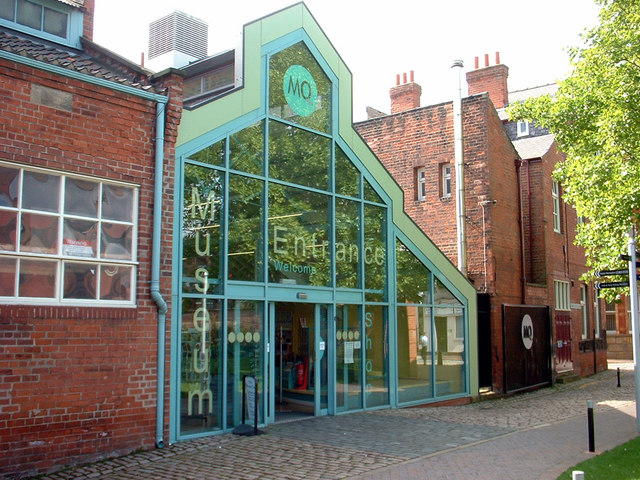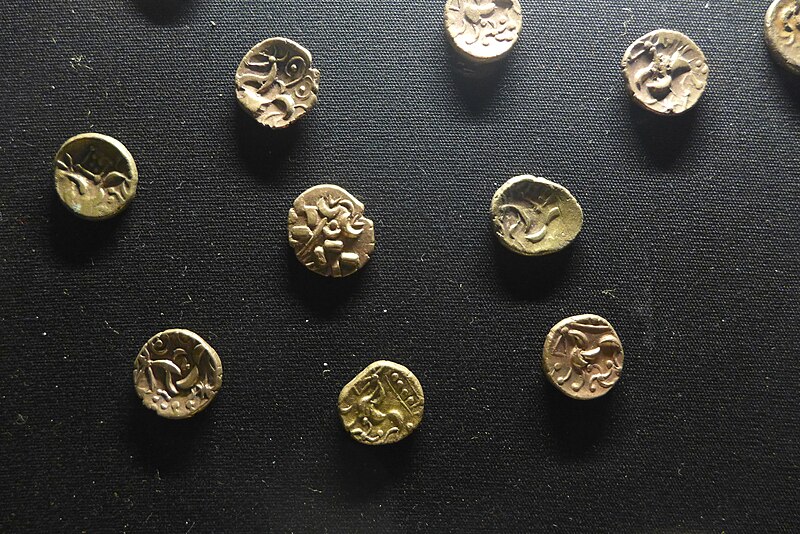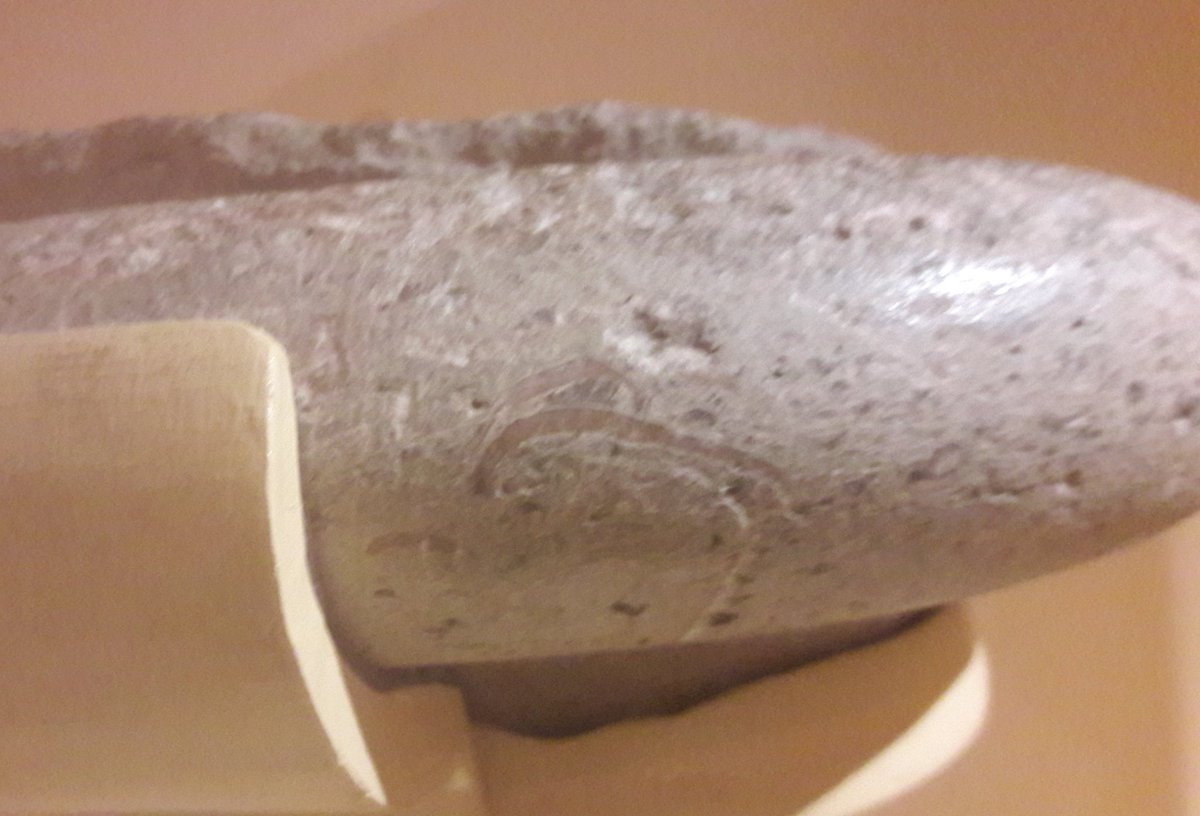Having had to postpone Strike and Dip, my inaugural industrial action teach-out, due to poor weather, I began looking around for other ways to carry on doing what I love - teaching geology and palaeontology - even whilst on strike.
After a couple of quick phone calls, I was delighted to be able to set up an event at the Hull & East Riding Museum, at 10am on Tuesday March 6th. As I should have been teaching an Earth Evolution class called "Fossils: Why bother?" at that very time, it seemed perfect to be able to ponder the purpose of palaeontology, whilst wandering round the region's natural history and archaeology museum instead. Shamefully, I'd never actually visited the museum before, so it also presented me with an ideal excuse to remedy my neglect.
I booked in a group of 'up to 40' people, but the actual number ended up being six: me, two PhD students, one third year undergraduate, and two second years. Any mild disappointment was soon assuaged by the fact that this was a perfect group size for properly exploring the museum. We had the entire place to ourselves!
After a brief rant in the entrance foyer about why I think museums are so important, and how brutally and short-sightedly the austerity agenda has been affecting them, particularly in disciplines such as palaeontology*, I suggested we venture inside. Nominally, I set us some questions to answer:
What is the most important geological specimen?
What is the most interesting geological specimen?
Where is geology most well-hidden in the collections?
What does the museum do well?
What could the museum do better?
Then off we went!
I have some detailed comments to make later, and of course, the questions to answer, but my simple summary sentence is: the Hull & East Riding Museum is terrific!
The first thing you encounter at the top of the stairs is a tunnel through time (and through the Chalk), with a couple of spinning dials aimed at a younger audience, to get them thinking about time and fossilization. Then you round the corner to come face to fur with a life-size (replica) mammoth. Only afterwards did I remember that he/she was called Mortimer.
In a bay round another corner is the geology/palaeontology display, showing off some of the many fossils found in East Yorkshire, and what they tell us about the region's evolution. And then we move into the Holocene, and begin to explore the quite simply extraordinary archaeology of East Yorkshire. And the collection of specimens on display in the museum is staggering: the Hasholme logboat, 2500 years old; complete Roman mosaics in room after room; the Roos Carr figures:
Why isn't this material shouted about from the rooftops? How has Hull hung onto it without the British Museum demanding it for the nation? Just how much more of it is there in the museum vaults? I found myself even more nonplussed that I'd never come in here before.
We planned to go in for about an hour, and then catch up again over coffee. Two hours later, I was having to dash back to put more money on my parking ticket and we still hadn't gone round the whole museum. There was simply too much interesting stuff to look at, and talk about. I think my favourite thing was learning that the earliest evidence of written language in Northern England comes courtesy of some early Leicestrians:
So, conclusions. How did we answer the questions?
What is the most important geological specimen?
I had to conclude that I'm not sure - most of the rocks and fossils on display are relatively familiar to me, so I didn't identify anything I regarded as of international significance. However, I'd really like to go behind the scenes and learn more about the collections and the collectors, to try and flesh out the geological histories a little more.
What is the most interesting geological specimen?
It's rather niche, but the thing I found most interesting was that Church Hill, Holme-on-Spalding Moor, is made of Mercia Mudstone. Triassic mudstones and sandstones form the bedrock underlying almost all of the Vale of York, but I've never actually seen them, as they're always covered by glacial sediments. Next time I drive through Holme, I shall detour to Church Hill.
Where is geology most well-hidden in the collections?
Strangely, the geology is probably most well-hidden in the geology collections. You could just about bypass the geology gallery and go straight into the archaeology galleries, which then - counter-intuitively, perhaps - mention the importance of rock and mineral resources rather a lot. Stone Age rock factories, jet jewellery, mediaeval monuments: all are well-linked to their geological origins. I almost wonder whether it's worth turning the museum timeline on its head: start with Hull and the East Riding in its present, familiar geography, and then work back through time, into the deeper and dimmer past.
What does the museum do well?
The archaeology - so much amazing stuff, so much engaging interpretation, so many rooms.
What could the museum do better?Blow its own trumpet! The archaeology is world-class, and the city needs to make more of it. The signs around town that lead you to the museum are small, and not always easy to follow - if you're not from Hull, you could be almost oblivious to its existence.
On the geology/palaeontology front, we felt the displays were in need of a bit of refreshment and reinvention (the lighting was a bit patchy, and the film on the geology of Yorkshire could certainly be updated), and with a shortage of funding likely to be available for this, we came up with a plan. I'm not sure the six of us can strictly make decisions on behalf of the entire group, but I decided that Geology@Hull should try and help. With our splendid team of staff and students growing every year, it'd be great for us all to get more involved in supporting and promoting the geology of the city and county, and where better to do that than in the museum? Even if it's just the six of us who did the teach out, that'd be a start.
However, I shouldn't jump the gun. I've not even mentioned the idea to the good people at H&ERM. What I can confirm is that these teach-outs are tremendous fun, and if you'd like to join us on the next Strike and Dip, it will be a fieldwork teach-out, this Monday at 10am in the Humber Bridge Country Park. The calcareous king, Dr Mike Rogerson, will be in charge, and There Will Be Chalk. Hope to see you there!
*I plan to blog about this another time, although I'll probably forget, so please do give me a nudge.
After a couple of quick phone calls, I was delighted to be able to set up an event at the Hull & East Riding Museum, at 10am on Tuesday March 6th. As I should have been teaching an Earth Evolution class called "Fossils: Why bother?" at that very time, it seemed perfect to be able to ponder the purpose of palaeontology, whilst wandering round the region's natural history and archaeology museum instead. Shamefully, I'd never actually visited the museum before, so it also presented me with an ideal excuse to remedy my neglect.
 |
| Hull and East Riding Museum (Wikimedia Commons) |
I booked in a group of 'up to 40' people, but the actual number ended up being six: me, two PhD students, one third year undergraduate, and two second years. Any mild disappointment was soon assuaged by the fact that this was a perfect group size for properly exploring the museum. We had the entire place to ourselves!
After a brief rant in the entrance foyer about why I think museums are so important, and how brutally and short-sightedly the austerity agenda has been affecting them, particularly in disciplines such as palaeontology*, I suggested we venture inside. Nominally, I set us some questions to answer:
What is the most important geological specimen?
What is the most interesting geological specimen?
Where is geology most well-hidden in the collections?
What does the museum do well?
What could the museum do better?
Then off we went!
| Not currently on display (Image: Hull & East Riding Museum). |
I have some detailed comments to make later, and of course, the questions to answer, but my simple summary sentence is: the Hull & East Riding Museum is terrific!
The first thing you encounter at the top of the stairs is a tunnel through time (and through the Chalk), with a couple of spinning dials aimed at a younger audience, to get them thinking about time and fossilization. Then you round the corner to come face to fur with a life-size (replica) mammoth. Only afterwards did I remember that he/she was called Mortimer.
In a bay round another corner is the geology/palaeontology display, showing off some of the many fossils found in East Yorkshire, and what they tell us about the region's evolution. And then we move into the Holocene, and begin to explore the quite simply extraordinary archaeology of East Yorkshire. And the collection of specimens on display in the museum is staggering: the Hasholme logboat, 2500 years old; complete Roman mosaics in room after room; the Roos Carr figures:
 |
| Quartzite eyes, detachable genitalia (Image: Hull & East Riding Museum) |
Why isn't this material shouted about from the rooftops? How has Hull hung onto it without the British Museum demanding it for the nation? Just how much more of it is there in the museum vaults? I found myself even more nonplussed that I'd never come in here before.
We planned to go in for about an hour, and then catch up again over coffee. Two hours later, I was having to dash back to put more money on my parking ticket and we still hadn't gone round the whole museum. There was simply too much interesting stuff to look at, and talk about. I think my favourite thing was learning that the earliest evidence of written language in Northern England comes courtesy of some early Leicestrians:
 |
| Coins of the Corieltauvi, Hull & East Riding Museum (Image by Notafly, Wikimedia Commons) |
So, conclusions. How did we answer the questions?
What is the most important geological specimen?
I had to conclude that I'm not sure - most of the rocks and fossils on display are relatively familiar to me, so I didn't identify anything I regarded as of international significance. However, I'd really like to go behind the scenes and learn more about the collections and the collectors, to try and flesh out the geological histories a little more.
What is the most interesting geological specimen?
It's rather niche, but the thing I found most interesting was that Church Hill, Holme-on-Spalding Moor, is made of Mercia Mudstone. Triassic mudstones and sandstones form the bedrock underlying almost all of the Vale of York, but I've never actually seen them, as they're always covered by glacial sediments. Next time I drive through Holme, I shall detour to Church Hill.
Where is geology most well-hidden in the collections?
Strangely, the geology is probably most well-hidden in the geology collections. You could just about bypass the geology gallery and go straight into the archaeology galleries, which then - counter-intuitively, perhaps - mention the importance of rock and mineral resources rather a lot. Stone Age rock factories, jet jewellery, mediaeval monuments: all are well-linked to their geological origins. I almost wonder whether it's worth turning the museum timeline on its head: start with Hull and the East Riding in its present, familiar geography, and then work back through time, into the deeper and dimmer past.
 |
| My extremely rubbish phone photo of a Purbeck Marble pediment. |
What does the museum do well?
The archaeology - so much amazing stuff, so much engaging interpretation, so many rooms.
What could the museum do better?Blow its own trumpet! The archaeology is world-class, and the city needs to make more of it. The signs around town that lead you to the museum are small, and not always easy to follow - if you're not from Hull, you could be almost oblivious to its existence.
On the geology/palaeontology front, we felt the displays were in need of a bit of refreshment and reinvention (the lighting was a bit patchy, and the film on the geology of Yorkshire could certainly be updated), and with a shortage of funding likely to be available for this, we came up with a plan. I'm not sure the six of us can strictly make decisions on behalf of the entire group, but I decided that Geology@Hull should try and help. With our splendid team of staff and students growing every year, it'd be great for us all to get more involved in supporting and promoting the geology of the city and county, and where better to do that than in the museum? Even if it's just the six of us who did the teach out, that'd be a start.
However, I shouldn't jump the gun. I've not even mentioned the idea to the good people at H&ERM. What I can confirm is that these teach-outs are tremendous fun, and if you'd like to join us on the next Strike and Dip, it will be a fieldwork teach-out, this Monday at 10am in the Humber Bridge Country Park. The calcareous king, Dr Mike Rogerson, will be in charge, and There Will Be Chalk. Hope to see you there!
 |
| Little Switzerland (Image by Paul Glazzard, Wikimedia Commons) |
*I plan to blog about this another time, although I'll probably forget, so please do give me a nudge.
Comments